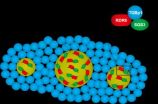(Press-News.org) TORONTO, June 2, 2014 — Even by three months of age, babies are visually able to locate objects that stand out from a group, a York University study has found.
"For example, an infant can pick a red umbrella in a sea of grey ones," says Psychology Professor Scott Adler in the Faculty of Health, who led the research. "This indicates that babies at a very young age are able to selectively extract information from the environment, just like adults."
Previously it was unknown how early this form of visual attention developed in infants. For the current study, both infants (34) and adults (10) were presented with certain visual search task, to measure the latency of eye movements in hundreds of milliseconds. For this study, in a 30-minute session, the infants were on their backs with the stimuli above them on a screen, while infrared light tracked their eye movements.
The study, Search Asymmetry and Eye Movements in Infants and Adults, recently published online in the journal of Attention, Perception, and Psychophysicsrevealed that infants, like adults, were able to pick out a single R character among increasingly larger groups of P characters. The R is considered to have a distinguishing, unique feature that stands out.
That means they are just as adept at locating specific stimuli among competing and distracting stimuli in their environment. In addition, the infants showed a similar an asymmetrical pattern of detection to locate the unique target as the adults.
The study also looked at what happened when infants and adults were given a "feature-absent" target among distracting "feature-present" objects, such as a P among varying sized groups of Rs. In this case, the infants were less efficient at finding the differing letter without a distinguishing feature.
"This is called 'bottom-up' attention and it comes from the environment and goes up into the processing system," explains Adler. "Top-down attention is where your goals, ideas and thoughts control where you attend. You have voluntary control over what information you're going to choose to process."
Bottom-up attention, is thought to be a more primitive, but key process that would, for example, allow a predator, such as a lion, to be noticed among a group of zebras. It is also when people notice something different or salient in their environment, such as a door suddenly opening and someone walking through it into a classroom.
With top-down attention, the ability to ignore certain stimuli in the search for something specific, such as lost keys, is greatly enhanced.
"The aim of the present study was to add to our understanding of infants' ability to selectively attend to particular items in the presence of competing stimuli by examining the development of selective attention mechanisms involved in visual search, particularly the role of bottom-up processing of stimulus salience," says Adler.
INFORMATION:
York University is helping to shape the global thinkers and thinking that will define tomorrow. York's unwavering commitment to excellence reflects a rich diversity of perspectives and a strong sense of social responsibility that sets us apart. A York U degree empowers graduates to thrive in the world and achieve their life goals through a rigorous academic foundation balanced by real-world experiential education. As a globally recognized research centre, York is fully engaged in the critical discussions that lead to innovative solutions to the most pressing local and global social challenges. York's 11 faculties and 27 research centres are thinking bigger, broader and more globally, partnering with 288 leading universities worldwide. York's community is strong − 55,000 students, 7,000 faculty and staff, and more than 250,000 alumni.
Media Contact:
Gloria Suhasini
York University Media Relations
416 736 2100 ext. 22094
suhasini@yorku.ca
Even at infancy, human can visually identify objects that stand out: York U study
Even by 3 months of age, babies are visually able to locate objects that stand out from a group, a York University study has found
2014-06-02
ELSE PRESS RELEASES FROM THIS DATE:
MRSA rates varied dramatically across geographic areas
2014-06-02
LOS ANGELES – (June 2, 2014) – The rates of community-onset methicillin-resistant Staphylococcus aureus (CO-MRSA) varied dramatically among academic medical centers in California, New York, Illinois and North Carolina, suggesting there is not a uniform change in the "national epidemic" of the "superbug" that has generated extensive public health concern over the past decade, according to a new study.
The study, published online ahead of print in the journal Clinical Infectious Diseases, surveyed hospital records of 4,171 cases of MRSA and MRSA-related infections between ...
Enzyme used in antidepressants could help researchers develop prostate cancer treatments
2014-06-02
LOS ANGELES (May 30, 2014) – An international team of scientists including researchers at the Cedars-Sinai Samuel Oschin Comprehensive Cancer Institute and the University of Southern California found that an enzyme commonly used as a target for antidepressants may also promote prostate cancer growth.
The study, published in the Journal of Clinical Investigation, found that suppressing the enzyme monoamine oxidase A, or MAOA, may reduce or even eliminate prostate tumor growth and metastasis in laboratory mice. The finding could open the door for physicians to use antidepressants ...
Virus rounds up enzymes, disarms plant
2014-06-02
University of Tokyo researchers have described how a plant-virus protein suppresses an important plant defense mechanism that remembers viral genetic information, providing a new target for developing the first-ever chemical against plant viruses that globally cause more than $60 billion of crop losses each year.
Invading viruses carry genetic material that hijacks the host cell's machinery, fooling it into producing proteins and new viruses. All cells from fungi to plants and mammals employ RNA silencing, a cellular process essential for the regulation of gene expression ...
New Population Council research presented at 13th ESC Annual Congress
2014-06-02
LISBON, PORTUGAL (31 May 2014) – This week, the Population Council presented new research at the 13th Congress of the European Society of Contraception and Reproductive Health. Presentations included a pharmacokinetic analysis of the Council's investigational one-year contraceptive vaginal ring containing Nestorone® and ethinyl estradiol, and its investigational male contraceptive implant MENT®, as well as new approaches to "green contraception," including strategies to ensure that future contraceptive technologies are both effective and protect the environment.
"The ...
Clinical trial shows drug combination may be effective in recurrent ovarian cancer
2014-06-02
VIDEO:
Dr. Joyce Liu talks about her clinical trial showing drug combination may be effective in recurrent ovarian cancer.
Click here for more information.
CHICAGO –– Significant improvement with the use of a combination drug therapy for recurrent ovarian cancer was reported at the annual meeting of the American Society of Clinical Oncology (ASCO) meeting in Chicago today. This is the first ovarian cancer study to use a combination of drugs that could be taken orally. The ...
New data shows ProMark accurately predicts aggressive prostate cancer, pathology outcomes
2014-06-02
CAMBRIDGE, Massachusetts, June 2, 2014 – Today, for the first time, Metamark presents results from the clinical validation study that showed ProMark™, the first and only proteomic-based imaging biopsy test, achieved its primary endpoint by accurately differentiating between aggressive and non-aggressive forms of prostate cancer at early stages of disease. ProMark™ was shown to predict which patients have low-risk disease with a sensitivity of 90 percent or better, confidently identifying patients who are appropriate for active surveillance or need aggressive therapy. The ...
Study shows tale of 2 prognoses in pediatric brain tumor, pilocytic astrocytoma
2014-06-02
Pilocytic astrocytoma (PA) is a primarily pediatric brain tumor caused mainly by mutations in the BRAF gene. In fact, there are two specific mechanisms for activation of BRAF implicated in PA formation: by fusion of the gene with nearby gene KIAA1549 (K:B fusion) or by point mutations of the BRAF gene itself. Research presented at the American Society for Clinical Oncology (ASCO) Annual Meeting 2014 used a newly designed test for K:B fusion to show that point mutations lead to a more dangerous form of the disease than does K:B fusion.
"Overall, the prognosis for Pilocytic ...
DREAM project crowdsources answer to cancer cell drug sensitivities
2014-06-02
A study published June 1 in the journal Nature Biotechnology describes the results of an open challenge to predict which breast cancer cell lines will respond to which drugs, based only on the sum of cells' genomic data. The winning entry, from the Helsinki Institute for Information Technology, was 78 percent accurate in identifying sensitive versus resistant cell lines, and was one of 44 algorithms submitted by groups from around the world.
"The idea is simple – we have this question and anybody can participate in searching for the answer. The question is, do we have ...
A master of disguise: A new stick insect species from China
2014-06-02
Many representatives of the fauna possess unique masking abilities but stick insects are among the masters of disguise within the animal world. During a field trip in Guangxi, China Mr. Ho Wai-chun George from the Hong Kong Entomological Society discovers a new species from this enigmatic insect group, which he describes in a recent research paper published in the open access journal Deutsche Entomologische Zeitschrift.
Like the name suggests the new stick insect Sinophasma damingshanensis is distinguished by peculiarly elongated body and green-brownish coloration, which ...
New species from the past
2014-06-02
A piece of Eocene Baltic Amber of about 45 million years age contains a well preserved extinct flat bug, which turned out to be a new species to science. This exciting discovery is one of the many secrets that deposits of Baltic amber have revealed in the last years and are yet to come in the future. The study describing the new species was published in the open access journal Deutsche Entomologische Zeitschrift.
The new species Aradus macrosomus is a rather large representative of the genus, differing by its size and particular structures from its congeners. The name ...
LAST 30 PRESS RELEASES:
iPS cells from dish to freezer and back
Deep neural networks enable accurate pricing of American options under stochastic volatility
Collective risk resonance in Chinese stock sectors uncovered through higher-order network analysis
Does CPU impact systemic risk contributions of Chinese sectors? Evidence from mixed frequency methods with asymmetric tail long memory
General intelligence framework to predict virus adaptation based on a genome language model
Antibiotic resistance is ancient, ecological, and deeply connected to human activity, new review shows
Vapes, pouches, heated tobacco, shisha, cigarettes: nicotine in all forms is toxic to the heart and blood vessels
From powder to planet: University of Modena engineers forge a low-carbon future for advanced metal manufacturing
Super strain-resistant superconductors
Pre-school health programme does not improve children’s diet or physical activity, prompting call for policy changes, study finds
Autumn clock change linked to reduction in certain health conditions
AI images of doctors can exaggerate and reinforce existing stereotypes
Where medicine meets melody – how lullabies help babies and parents in intensive care
We may never be able to tell if AI becomes conscious, argues philosopher
AI video translation shows promise but humans still hold the edge
Deep ocean earthquakes drive Southern Ocean’s massive phytoplankton blooms, study finds
Without campus leftovers to pick through, the beaks of this bird changed shape during the pandemic
High-dose antibiotic does not reduce mortality in tuberculous meningitis
How many insects fly in the sky above the USA?
Could cheese protect your brain health?
Who faces more difficulty recovering from stroke?
Colliding galaxies create the brightest, fastest growing black holes at their center
New BrainHealth research reveals tradeoffs on sleep with cannabis use for chronic pain
Aging-US now on ResearchGate, enhancing visibility for authors and readers
'Molecular glue' stabilizes protein that inhibits development of non-small cell lung cancer
Mount Sinai Health System is recognized in 2025 Chime Digital Health Most Wired survey
From prey to predator: How carnivores spread beneficial fungi
Menopause symptoms may be frequent and have negative effects, according to female endurance athletes
US Congressmembers’ responses on X to mass shooting events differ along party lines
KAIST-UEL team develops “origami” airless wheel to explore lunar caves
[Press-News.org] Even at infancy, human can visually identify objects that stand out: York U studyEven by 3 months of age, babies are visually able to locate objects that stand out from a group, a York University study has found





